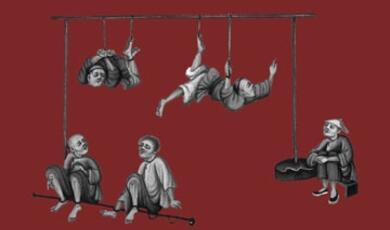The Pathology of Discovery and Conquest
Share
- Details
- Transcript
- Audio
- Downloads
- Extra Reading
This lecture examined the spread of diseases that accompanied European expansion overseas from the fifteenth century, paying particular attention to their demographic impact in Americas.
Download Transcript
Linda A. Newson
When Christopher Columbus arrived in the island of Hispaniola (today shared by the Dominican Republic and Haiti ) in 1492 it had a conservative population of about one million. By 1540 only 250 people remained. Demographic disaster, although perhaps not always as extreme as this, accompanied Europeans wherever they went. Although considerable controversy exists over the size of the contact populations, it would appear that the initial impact of colonial rule was greatest in the Americas and in remote regions such as the Pacific Islands where within the first 100 to 150 years of contact the population is thought to have declined by as much as 80 to 95 per cent. Hence in 1778 the Hawaiian islands had a conservative population of about 250,000 in the Hawaiian islands in 1778, but by the 1890s only 40,000 remained. Similarly, in Tahiti an estimated population of 66,000 in 1774 had fallen to about 6,000 by 1881.
Of course many factors contributed to this decline. Some people were killed in military encounters with Europeans, while others died as a result of harsh work, ill treatment and slavery to which they were subsequently subjected. The brutality of Spanish rule in the Americas came to be known as the Black Legend, which Spain ’s enemies used to discredit her rule in the New World . Books and illustrations of the Spanish treatment of the native peoples circulated widely in Europe , such as those of the Flemish engraver Theodore de Bry.
Other losses came about through transformations to native economies and societies that were brought about as a consequence of colonial rule, though the extent of these changes varied according to the objectives of European powers and the types of societies they encountered. Trading empires were much less intrusive than those where there was extensive European settlement and where colonial powers sought establish productive economic enterprises that generated demands for labour and land and/or sought to convert and ‘civilise’ native peoples. Where contacts were most intense, economic and social restructuring was greatest, and native peoples suffered the greatest decline. In most cases the relative importance of such changes is difficult to assess because many of the processes that contributed to demographic decline were complex and are difficult to quantify. However, most scholars agree that a significant factor in population decline in many regions was the introduction of Old World diseases to which native peoples possessed no immunity.
Native Americans had been unable to develop immunity to Old World diseases due to their isolation, and this was probably also the case for the Pacific Islanders. There were also remote parts of the Old World which acute infections had failed to reach or where they had failed to become endemic prior to European expansion because their populations were small and dispersed. For example, the heavy losses sustained by the Hottentots in South Africa in a smallpox epidemic in 1713, suggests that they did not have immunity to the disease and that it had not become endemic in the region. Similarly smallpox and measles probably reached the Philippines through trading contacts, probably with China in pre-European times, but people did not develop immunity to them. This was because when acute infections were introduced they would spread rapidly through the population, but then die out because of the lack of further people to infect. As a result they did not become endemic so people were unable to acquire immunity to them. Evidence from island communities suggests that for measles to become endemic it is necessary to have a population of 500,000. Since smallpox spreads less rapidly than measles, the estimated threshold is lower at 200,000. Historical experience suggests that at least a century of constant exposure to a disease is required for it to become endemic, as individuals who are more resistant reproduce and those who are not die in childhood.
However, it was not only the introduction of new diseases that caused devastation, but also changes to the natural environment that accompanied European rule that facilitated the spread of existing, as well as new diseases. Finally, in discussing the pathology of conquest, it is worth noting that, depending on their destination, victims of European colonial expansion often included Europeans themselves, for those bureaucrats, priests, soldiers, sailors and colonists who ventured overseas also suffered highy mortality.
The Impact of Old World Diseases in the Americas
The pathogenic impact of conquest is best documented in the case of the Americas. Here the native population may have fallen from between 50-60 million in 1492 to about 6 million a century and a half later. A significant factor in this decline was the introduction of acute infections such as smallpox, measles, plague and typhus, to which Native Americans due to centuries of isolation had been unable to acquire immunity. As a result each epidemic might carry off 20, 30 or maybe even 50 percent of the population. These proportions are recorded in documentary sources and have been corroborated by historically more recent epidemics among non-immune populations, for example, in outbreaks of measles that occurred in Iceland from the mid-nineteenth century and more recently among the Yanomamo in the Amazon Basin in the 1960s, though here mortality was moderated through swift vaccination.
Before exploring the impact of disease more fully, it is worth noting that there are differences in the way that diseases are spread. Whereas smallpox, measles, influenza and rubella are spread through face-to-face contact, others are spread by vectors, such as rodents or insects. Hence, yellow fever and malaria are spread by mosquitoes, and bubonic plague or typhus are spread by lice or fleas living on rodents. Those spread by face-to-face contact can spread rapidly, but those dependent on a vector also require the introduction of a suitable host, such as rats, or have to find an appropriate one in their new environment. Hence, yellow fever probably did not appear in the Americas until there was an outbreak in the Caribbean and Yucatán between 1647 and 1649, because its spread required the introduction of the Aedes aegypti mosquito from Africa. It was only with the increased scale of the slave trade in the seventeenth century that these insects were carried to the Americas, breeding in water barrels of slave ships. Earlier descriptions of people dying with yellow skin are now thought to be due to shortages of food during prolonged sea journeys or expeditions.
Until recently it was thought that the first major epidemic to hit mainland Latin America was an outbreak of smallpox in the Aztec capital Tenochtitlán (now Mexico City) in 1520. A graphic account by an Aztec recorded that,
“A great plague broke out here in Tenochtitlán. It began to spread during the thirteenth month (October 1520) and lasted for seventy days, striking everywhere in the city and killing a vast number of our people. Sores erupted on our faces, our breasts, our bellies; we were covered with agonising sores from head to foot.
The illness was so dreadful that no one could walk or move. The sick were so utterly helpless that they could only lie on their beds like corpses, unable to move their limbs or even their heads. They could not lie face down or roll from one side to the other. If they did move their bodies, they screamed with pain.
A great many died from this plague, and many others died of hunger. They could not get up to search for food, and everyone else was too sick to care for them, so they starved to death in their beds.”
This same epidemic later spread through Guatemala, the rest of Central America, Panama, and from there along the Pacific Coast to Peru. While such diseases could have been carried by expeditions of conquest, equally they could have passed from one native community to another without the presence of Europeans. This probably occurred in Peru where there is evidence to indicate that smallpox struck the Inca empire before the arrival of Europeans in the 1520s. It was to play a decisive role on the course of Spanish conquest, since it not only resulted in high mortality weakening native resistance to Spanish rule, but among its victims was the Inca emperor, Huayna Capac, whose death resulted in a dynastic war between his two sons Huascar and Atahualpa. When Francisco Pizarro’s expedition arrived therefore the Inca empire had already suffered major population losses and was in the throes of a civil war. The Incas claimed that if the Spaniards had arrived a few years earlier they would not have been conquered so easily.
The fact that diseases might run ahead of the invaders has prompted suggestions that societies in more remote regions such as North America and Amazonia may have been much larger than generally supposed since the first European eye-witnesses observed societies that had already been devastated by epidemic disease and suffered significant decline. There is therefore considerable controversy over the size of the native population of the Americas in 1492, with estimates range from Alfred Kroeber’s 8.4 million to Henry Dobyns’s over 112 million, but this is a topic for another lecture.
Until recently it was thought that the 1518 smallpox epidemic just described was the first to hit the New World, but a Spanish medical historian, Francisco Guerra, has recently presented persuasive evidence that influenza was carried to Hispaniola by Columbus’s second expedition in 1493. This disease apparently originated in pigs and spread to horses and then the passengers, and subsequently to Indians, who died in “infinite numbers.” Even if this was disease was not influenza, other scholars have argued that it is very unlikely that no disease transfer occurred for a quarter of a century before the 1518 outbreak.
While single epidemics might carry off one-third or one half of the population, the problem was that native societies were being hit not once but by successive epidemics which each took a significant toll of the population. Hence David Cook had shown how six major epidemics alone could have reduced the Andean population by over 90 percent during the sixteenth century. This is without taking account of the demographic impact of conquest itself or any losses in military encounters or resulting from transformations to native societies that occurred with colonial rule.
An interesting feature of the impact of Old World diseases in the Americas is that the decline was greater in the lowlands than the highlands. In the lowlands the native population was later replaces as a labour force by African slaves. The higher levels of depopulation in the tropical lowlands have often been attributed to the tropical fevers, malaria and yellow fever, and to the greater prevalence of waterborne intestinal infections such as dysentery, typhoid, hookworm and other helminthic infections. Nevertheless, as indicated above yellow fever cannot be implicated in the early depopulation of tropical coasts since its arrival in the mid-seventeenth century post-dates this period. Similarly, although Anophelesmosquitoes capable of transmitting malaria were present in the New World in pre-Columbian times, the deadly Plasmodium falciparum found in Africa probably did not arrive until the slave trade gathered momentum. However, the milder form of malaria associated with Plasmodium vivax, which was endemic in the Mediterranean, was probably carried to the New World in the blood of early conquistadors and colonists and the parasite picked up by waiting mosquitoes. It would appear that some of those involved in the Columbus’s fourth expedition from 1502 to 1503 suffered from quartan fevers, often associated with vivax malaria and this may have resulted in the establishment of the disease in the New World. However, the disease may not necessarily have been introduced by this expedition, but by any number of Europeans who travelled to the New World, since once contracted malaria does not necessarily kill its victim, but the parasite remains in the blood. Even though malaria may have been introduced at an early date, it would have taken some time to become established and may not have affected areas of low population density where there were insufficient humans to maintain the chain of infection. Even today the low population density means that falciparummalaria is absent from many parts of Amazonia.
While malaria may have contributed to the decline of lowland populations in some regions, it cannot explain all lowland losses. Some of the heaviest losses in the colonial period were sustained on the desert coast of Peru, where the environment was unsuitable for the spread of malaria, so clearly other factors were involved. Also, some acute infections, such as typhus and pneumonic plague would have been more common in the highlands since they are generally associated with cool dry climates.
It was not only disease mortality that resulted rapid population decline, but also its indirect effects which affected the ability of societies to continue to function an recover. One immediate effect in some areas, particularly in lowland communities, was to increase intercommunity conflict. In many Amazonian groups, sickness and death were attributed to sorcery that required revenge, so that increased levels of intertribal warfare, which raised mortality even higher, often accompanied epidemics.
Other effects were subtler, but many resulted from indirect effects of the loss of a large proportion of the adult population. Labour losses undermined subsistence production resulting in food shortages and occasionally famines. Food production prospects depend on whether subsistence strategies or co-operative activities could remain viable with reduced populations. For example, in the Andes the rapid decline of native population made it difficult for communities to maintain their irrigation works and terraces. There are currently 600,000 hectares of abandoned terraces dating from pre-Columbian times in the Peruvian Andes alone.
In small societies too the loss of only a small number of people with special skills, such as those possessed by hunters, might have been a serious threat to food supplies, particularly in regions of marked seasonality or where groups are dependent on a limited range of resources.
While food shortages might not result in starvation and death, they might increase susceptibility to some diseases, but not all. In the case of measles and most respiratory and intestinal infections levels of morbidity and mortality appear to increase with poor nutrition, whereas smallpox, plague, yellow fever and malaria seem to be relatively unaffected. In any case, nutritional status would have also varied with energy requirements, which would have been greater in colder climates and where individuals were involved in arduous labour, such as mining, or were constantly fighting infection.
Adult losses also affected fertility and the ability of populations to recover from epdiemics. Not only did acute infections bring an immediate loss in reproductive capacity, but also disrupted reproduction as those who had lost spouses sought new partners. The formation of new unions was particularly difficult in small communities. Here the marriage pools were small and there were often marked differences in sex ratios, in addition there were often cultural restrictions on the suitability of marriage partners and on re-marriage. In order to ensure their survival, groups might have to modify their cultural practices. It is noteworthy that many surviving indigenous societies are exogamous and in the past have been prepared to absorb or be absorbed by outsiders.
The ability of societies to recover from the ravages of epidemics was also affected by physiological and psychological responses to the changed circumstances of colonial rule. The ‘loss of the will to survive’ among those who fell sick would have enhanced mortality, while early colonial observers also suggested that in the early colonial abortion and infanticide increased as parents were unable to support their offspring or did not wish them to endure the hardships they had experienced.
Probably more significant influences on fertility rates, however, were unconscious stress-induced amenorrhea and the breakdown in social relations caused by epidemics and external demands for labour. Whatever the causes, there is evidence that during the early sixteenth century family size fell. For example, a study of Huánuco in Peru suggests that family size declined from six in pre-Columbian times to 2.5 in 1560
The impact of epidemics was not confined to the early sixteenth century. It is true that in the early colonial period state societies suffered the heaviest disease mortality for it was here that Spaniards settled in largest numbers introducing a wide range of infections whose spread was facilitated by their dense populations. Interestingly people have argued that the Old World diseases had a greater impact in Central Mexico where the topography enabled them to spread out in a radial fashion, than in the Andes where communities were often located in deep valleys separated by steep mountain spurs, which acted as a barrier to their spread. Even so, these populous societies generally bore the brunt of conquest with wars and depopulation causing major political, economic and social upheavals that heightened disease mortality despite the efforts of the colonial authorities to ensure adequate food supplies and medical care. Nevertheless, despite heavy population losses, sufficient numbers remained for diseases to become endemic and for remaining populations to develop immunities to them, so that in the longer term the impact of acute infections was moderated. It meant that in the highland areas in particular, from the seventeenth century the native population was able to achieve a degree of recovery.
In contrast it areas where the population was small and dispersed the opportunities for the introduction of diseases were fewer and their spread was more difficult. Very often it was missionaries who unwittingly carried diseases to remote areas. In these circumstances not every community would have been hit by every epidemic, but the populations that remained were insufficient for acute infections to become endemic. As a consequence, when they were reintroduced they continued to cause high mortality that affected adults as well as children, and these had particularly adverse effects on food production and fertility. As such the populations in these regions did not experience the recovery that occurred in the highlands but continued to decline throughout the colonial period.
Pre-Columbian diseases in the New World
Having described the rather complex impact of Old World diseases on the Americas in particular, probably one question in your mind is whether Native Americans had any infections that travelled the other way and had equally devastating effects on Europeans.
First it is worth distinguishing between infections that can survive in small, dispersed populations and acute infections, which swiftly kill their victims or produce long-lasting immunity, which require a large population in order to become endemic. It is clear that gastrointestinal and respiratory infections were common in the New World , and skeletal remains from Peruvian mummies indicate that tuberculosis was present. All these infections can survive in small populations. Although in pre-Columbian times there were populations large enough to sustain acute infections in the Americas, with the probable exception of typhus, these appear to have been absent. Most acute infections to afflict human populations have had their origin in domesticated animals and then jump the species barrier to become human diseases. Hence, smallpox is related to cowpox and influenza to swine or avian ‘flu. This is, of course, our current concern over the outbreak of the particularly virulent H5N1 strain of bird flu’. Transfers from animals to humans tend to occur from domesticated animals rather than wild species since these are the ones with which humans have the closest contact. However, outbreaks may also occur where humans intrude upon a disease cycle established in animals, such as bubonic plague in rodents, yellow fever in monkeys, and rabies among bats.
Prior to 1492 the Americas possessed only a few domesticated animals notably llamas, alpacas, muscovy duck, turkey, dog and guinea pig, from which diseases might spread, but many of these did not come into close contact with humans – in the Andes llamas were herded in the punaabove settlements which were located on lower valley slopes. There is a possibility, however, that typhus may have been present, being spread by lice carried by guinea pigs, which were often kept in Andean households, as they continue to be today.
The question of venereal syphilis
It is often said that syphilis was the only disease of significance to be carried back to Europe from the Americas. However, there is considerable controversy over this issue. It is agreed that the first major outbreak in Europe occurred during the French invasion of Italy aimed at wresting the kingdom of Naples from Spanish influence in 1494-95. The outbreak forced French troops to withdraw, and when they were disbanded they spread the disease throughout Europe. Hence, it has been termed the ‘French pox’ or the ‘French disease’ [morbus gallicus].
The coincidence of this date with Columbus’ arrival in New World is suggestive, as is the absence of skeletal evidence and medical descriptions of syphilis from the Old World prior to 1500 - although it is possible it could have been confused with other diseases, for example, leprosy. Also, there are some skeletal remains in the New World that have lesions that are suggestive of venereal syphilis, but unfortunately they are difficult to distinguish from those caused by yaws or endemic syphilis which are thought to have been present in pre-Columbian times. (Endemic syphilis is spread by skin contact, but not venereally and its transmission is not very effective). Others claim that the syphilis that hit Italy in the late fifteenth century was a particularly virulent strain that emerged as a result of mutation, but this is difficult to prove using historical or medical evidence.
Veneral syphilis is one of four diseases called treponemal diseases, the others being pinta, yaws, and endemic syphilis. Rather than posit an introduction from the Americas, other medical historians propose a unitary theory that suggests that they are caused by the same bacterium (Treponema pallidum), which spreads and manifests itself in different ways according the environmental conditions, such as temperature or humidity, or human conditions, such as sanitation and the degree of close contact. One piece of evidence to support this theory is that immunity to one infection provides some cross-immunity to the other.
This issue of the origin of veneral syphilis has been debated for five centuries and one way that it may be resolved in future is if we can find evidence of antibodies to specific treponemal infections in skeletal remains.
Syphilis and other venereal diseases, such as gonorrhoea, were to have devastating demographic effects throughout the world. Introduced to the Pacific Islands by James Cook’s expeditions in the late 1760s and 1770s, they not only resulted in raised mortality, but also induced sub-fecundity that severely affected the ability of populations to recover from these and other diseases. This underlines the point made earlier that acute infections contributed to population decline not only directly through killing their victims, but also indirectly through affecting fertility.
Environmental influences
Environmental changes brought by Europeans also affected the incidence of disease. In many regions of Africa and southeast Asia forest clearance and the extension of irrigation encouraged the spread of malaria, by bringing the mosquitoes down to ground level and by creating pools of standing water that were attractive breeding grounds for them. In areas of low population density where there are insufficient people to maintain the malarial chain of infection, the introduction of livestock might also lead to the spread of disease since they might constitute alternative blood meals for the mosquitoes.
The impact on of diseases encountered by Europeans
It wasn’t only those who were conquered by Europeans who succumbed to disease, but also those who were employed in its service. Scurvy caused by a shortage of vitamin C was a common affliction of sailors who spent long periods at sea. It was characterised by swollen bleeding gums, which often resulted in tooth loss, fatigue, joint pain, and breakdown in cell tissue, and in extreme cases death.
One of the earliest descriptions of scurvy was by the Portuguese navigator, Vasco da Gama, who described it on his journey around the Cape of Good Hope to Goa in 1497, when perhaps half of his fleet’s company died of the dieases. A Portuguese historian commenting on this expedition suggested that “if the dead who had been thrown overboard between the coast of Guinea and the Cape of Good Hope could have had headstones placed for them on the spot when they sank, the whole way would appear as one cemetery.” Similarly, on Ferdinand Magellan’s expedition across the Pacific in 1521 a survivor reported that “the upper and lower gums of our people swelled so much they could not eat and they died.” It has been suggested that between 1600 and 1800 more than one million sailors died of scurvy, probably more than all the deaths from shipwrecks, naval wars and other diseases combined. Although many people were aware of the benefits of fresh food, including the use of citrus fruits, from the sixteenth century, these were not readily available to northern Europeans and were perishable. Various plants were erroneously thought to have curative powers, including spoonwort (Cochlearia officinalis) that was called ‘scurvy grass’ but actually contained little vitamin C.
The benefits of citrus fruits were not demonstrated clinically until James Lind’s shipboard experiment in 1747, when he divided twelve sailors suffering from scurvy into six groups which in addition to their basic diet fed of gruel and mutton were given an additional item, which was either cider, vinegar, seawater, an elixir of vitriol (metal sulphate), a mixture of garlic, mustard and horseradish, and of course oranges and lemons, and found that only the last made a full recovery. He subsequently published a treatise on scurvy in 1753.
Other hazards of overseas exploration threatened soldiers and colonists as they moved into new territories and encountered unfamiliar diseases. While Africans had some immunity to malaria and yellow fever, these diseases proved deadly for Europeans, and the coast of Africa earned an early reputation as the ‘White Man’s Grave’. As such, slave-trading ships timed their arrival on the coast of Africa to coincide with the healthiest season of the year and spent as little time as possible in the region, sometimes remaining on board ship away from coast. The West African coast around the Gambia River proved to be a particularly deadly environment for Europeans for here the well watered environment of alluvial flats and mangrove swamps constituted good breeding grounds for mosquitoes, while the surrounding forest harboured monkeys and baboons that acted as hosts for the yellow fever virus. Death rates among the crew of slave ships were often as high as those for slaves, but whereas the crew often succumbed to malaria and yellow fever; the slaves, who had some immunity to them, died of gastrointestinal infections, particularly dysentery. The high risk to which Europeans were exposed was reflected in the higher wages that were paid to the crews of slave ships; wages for sailors were about 20 percent higher than comparable trade and they received and they received more substantial advances.
To a large extent the organization of the African slave trade remained in the hands of Africans with relatively few European personnel residing permanently onshore to oversee operations, but those who did had a low life expectancy. English personnel sent to Africa by the Royal African Company in the late seventeenth century could only expect to live for another four or five years, and even in the eighteenth century about half of the Europeans arriving in the Gulf of Benin died within their first year of residence. Phillip Curtin has explored the death rates experienced by British troops overseas in an aptly titled book Death by Migration. But as any traveller knows, even travelling between ‘healthy environments might pose a risk to health and prior to the development of scientific medicine this risk was considerable. Hence one in ten of migrants to North America in the seventeenth century died before they reached their destination, and of those who arrived another 15 percent died within the first year of residence.
Conclusion
I have only had time to touch on a limited number of diseases and in a limited number of places, but I hope I have shown, as William McNeill has demonstrated in his magisterial book Plagues and Peoples, that the history of disease is an integral part of human history. The movement of diseases should be counted as part of the extensive Columbian exchange in animals, plants and humans that occurred in the wake of Columbus’s arrival in the New World in 1492.
There have been a number of debates as to whether disease or colonial rule was responsible for the decline of native populations following European contact, often referred to as the ‘guns versus germs’ debate. It has figured recently in Jared Diamond best-selling book, “Guns, Germs and Steel”. Although I have only looked at the ‘germs’ part of this debate, hopefully I have been able to show indirectly that this is a false dichotomy and that the spread and impact of diseases cannot be understood without knowledge of the social and environmental context into which they were introduced, much of which was shaped by colonial rule. Disease transfers were complex rather than simple processes that affected different peoples in different places in different ways.
© Professor Linda, Newson Gresham College, 27 March 2006
This event was on Mon, 27 Mar 2006
Support Gresham
Gresham College has offered an outstanding education to the public free of charge for over 400 years. Today, Gresham plays an important role in fostering a love of learning and a greater understanding of ourselves and the world around us. Your donation will help to widen our reach and to broaden our audience, allowing more people to benefit from a high-quality education from some of the brightest minds.


 Login
Login







